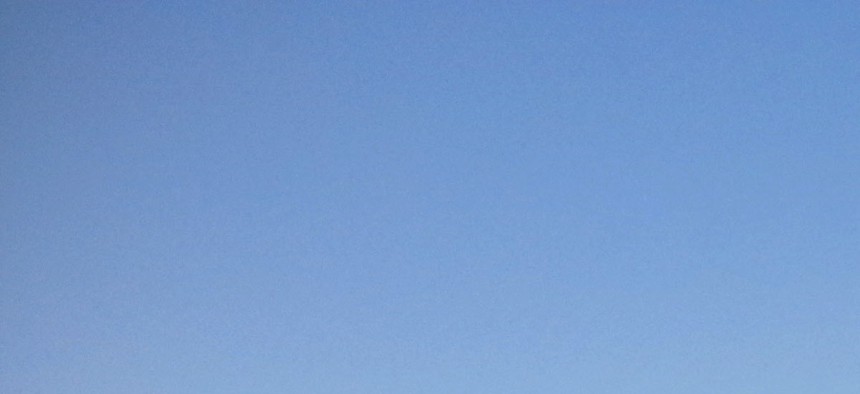
ISIS fighters stand with a captured Iraqi army Humvee at a checkpoint outside the Beiji refinery, 155 miles north of Baghdad, Iraq. AP Photo
The Top Secret Military Mapmakers Spying on ISIS' Oil Smuggling
Analysts at the NGA have taken the tradecraft used to spy on Russia and China and turned it on black market oil transports.
On March 3, an analyst at the Pentagon's clandestine map-making agency briefed the director on a new method for aiding the fight against the Islamic State. By eyeing signs of the black market oil industry, the agency can glean clues to help its partners choke off the source of ISIS' money and fuel.
Such resources helped suspected Islamic extremists in Tunisia slay more than 20 people Wednesday, including many tourists.
Part of the underground trade might physically be underground and out of sight. But some of the transport is visible to the trained eyes of experts at the National Geospatial-Intelligence Agency.
"Our analyst was having to take tradecraft that was honed on doing China and Russia,” and saying, “Well, here is what a black market oil industry looks like. And it was fascinating," NGA Director Robert Cardillo said in an interview with Nextgov.
Agency officials would not go into details about the specific visual indicators, because that could reveal security-sensitive information. However, officials said they are acquainted with a new report by the nonprofit Financial Action Task Force that describes the handoffs. NGA is a big proponent of harnessing open source information.
So, it's conceivable NGA is monitoring the physical transport of oil in individual trucks and oil drums, as well as portable refineries.
Because coalition airstrikes have eviscerated oil fields, ISIS has taken to using "modular" portable refineries and burning crude in open pits to make fuel, according to the study released last month by the Financial Action Task Force.
"By their nature, these refineries can be replaced and rebuilt by importing replacement parts and machinery," the report stated.
Oil smuggling in other countries, historically, has involved some observable infrastructure, even if it's only small trucks that carry unrefined crude back and forth from ports, one private investigator said. The vehicles might be as nondescript as a water truck or as large as a traditional New Jersey tanker truck. Nothing emblazoned with an ISIS flag, to be sure.
When stateless groups like Hezbollah or sanctioned regimes, such as Iran, participate in the black market industry, it's usually a state-owned company that steps up to buy the goods.
With barrels of oil trading at $43 globally, the firm will gladly accept light crude at maybe $20 a barrel, no questions asked. The ill-begotten oil then enters the legitimate economy. And the rogue group now has a source of quick, steady cash.
Strike the Pump Jack or Strike the Bank?
When NGA determines what to observe, the entire U.S. operation must be updated on the intelligence, Cardillo said.
"Now we turn that into our customers at Central Command, our customers at Defense, Pentagon and over at State. My intent is to help them think about" how to constrain this activity because the U.S. response “can be kinetic, sometimes it can be diplomatic, sometimes it can be financial -- perhaps all three are necessary," he said.
(Related: The Pentagon’s Satellite Spies Are Aiming for the Arctic)
For example, during the past month alone, military airstrikes have hit a mobile oil rig, multiple oil pump jacks, a modular oil refinery, and two crude oil collection points in Syria, according Defense. The Treasury Department has impeded cash flows by cutting off the bank accounts of traders, refiners and transport companies, who blow their covers by operating in the legitimate economy. And then there are ongoing diplomatic efforts to block cross-border oil smuggling routes in Turkey and Iraq.
"We need to inform not just our government, but the Iraqi government" about oil smuggling, "how and where we think that’s happening because it’s in our interest to cut out not just that production but the financial reward that they are gaining from that production,” Cardillo said.
As of last October, according to Quartz, ISIS still maintained fields capable of producing 20,000 barrels daily, which could pull in $500,000 a day, and still leave enough surpluses to power its own transportation. But estimates vary, due to the group’s tendency to put up smokescreens. Around the same time, Treasury was estimating a $1 million-a-day haul.
Other Invisible Networks to Watch
Aside from charting supply networks, NGA is diagraming social networks and other interpersonal connections that don't show up on traditional maps.
ISIS militants "are very active" in social media and "we leverage it to figure out where they were, what they were doing, how does that video connect to that location," Cardillo said.
Nongovernmental researchers have found that if an ISIS supporter has turned on the location feature on a smartphone, anyone can detect cellular signals that approximate that individual's geographic coordinates.
A new analysis by the Brookings Institution found, predictably, that few sympathizers enable that feature when tweeting -- around 300 of the 20,000 users studied, or 1.5 percent.
"The number who did was surprisingly high given the operational security implications," wrote the report's authors J.M. Berger and Jonathon Morgan. The largest cluster of pro-ISIS accounts was traced to areas in Syria. None of the users were inside the United States.
ISIS is aware of the risk of leaving digital bread crumbs. Last December, it ordered members to disable GPS on their mobile devices within one month, according to Brookings. It's unclear whether followers complied, partly because users can rig phones to reveal falsified GPS coordinates.
"ISIL’s very nuanced . . . They survive by blending in," Cardillo said of the group’s tactics in general. For NGA, “a company that works on images and signatures, it makes it much more difficult, not impossible, but much more difficult."
And any map can become quickly outdated in this conflict.
Sometimes, Cardillo will ask an analyst, "Can you take those Rand McNally lines off for a second? ... Sykes and Picot wrote those out on a cocktail napkin in London in 1916," he said, referring to the British and French diplomats, who forged an agreement dividing regions in the former Ottoman Empire.
NGA is more interested in so-called human geography -- the overlay of cultural, sectarian, tribal and other demographic features on top of physical features.
"Syria, when we see that shape, doesn't really exist anymore," he explained. "I think it can be much more helpful when you think about the challenge of ISIL without seeing those, what I think are, mainly artificial boundaries today."
NEXT STORY: War by Doxxing




